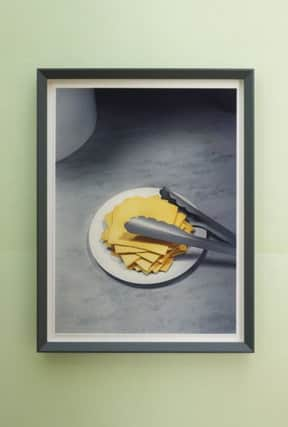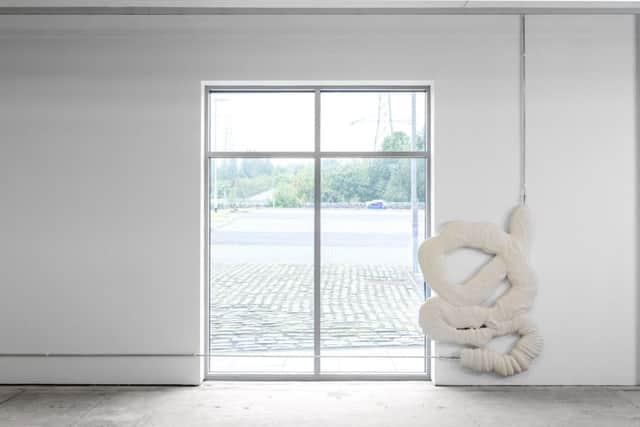Art reviews: Thomas Demand: Daily Show | Nicolas Deshayes: Darling, Gutter


Thomas Demand: Daily Show | Rating: **** | The Common Guild, Glasgow
Nicolas Deshayes: Darling, Gutter | Rating: **** | Glasgow Sculpture Studios
Advertisement
Hide AdAdvertisement
Hide AdThese are familiar sights: a row of uniform fluorescent strip lights and a grid of those white, perforated ceiling tiles that most of us work under every day. Four of the tiles have fallen off, leaving little yellowing punctuation marks of adhesive. This is ordinary stuff, the matter of a momentary glance.


Yet the investment in this image of an office ceiling, entitled Daily #5 and hanging in the hallway at the Common Guild in Glasgow, is in inverse proportion to its quotidian nature. For this modest framed work is both more and less than it appears.
Daily #5 is a painstaking recreation of a casual iPhone snap, the scene recreated in cardboard and paper and rephotographed by its creator, the German artist Thomas Demand, in his Los Angeles Studio. It was printed by Guy Stricherz in a remote workshop in the Pacific Northwest. He is one of the last great colour printers and the man who worked with legendary US photographer William Eggleston.
Stricherz uses the complex and long-obsolete dye transfer process and some of the last of the necessary Eastman Kodak materials on the planet. Each work took up to four weeks of testing and up to 40 hours for a print. Demand has worked on the series, entitled The Dailies, since 2008. There are currently 26 pictures in the series and they must end when Stricherz’s stock runs out.
Demand, who rose to prominence in Berlin, studied and now teaches sculpture. He has been the subject of major museum shows at the Museum of Modern Art, New York in 2005 and at the Neue Nationalgalerie, Berlin in 2009. He is not a trained photographer, or perhaps even a photographer at all in the conventional sense.
The role of the studio photograph in the work that has led to him being recognised as one of the leading artists of our time arose in the early Nineties from a kind of necessity. Demand was imprisoned by the impracticalities of a potential archive that might threaten to swallow him.
Now his work sits on the cusp between the digital now and the analogue then he grew up in; between the world as we remember it in our mind’s eye and the world as we record it in the thousands of images we carry in our pockets every day.
Some of Demand’s best-known works have the density of a contemporary novel. Kitchen (2004) for example, was a reconstruction of the compound near Tikrit where Saddam Hussein was captured. Demand’s 1999 film Tunnel features an unnamed underpass that can’t help but recall the death of Princess Diana.
Advertisement
Hide AdAdvertisement
Hide AdThe artist has said these recent works are more like haikus. There is a sense in many of them of something beautiful yet incomplete. Hanging in the Common Guild’s office is Daily #1, an image of a skirting board above which a loose electrical socket is dangling. The world, through Demand’s eye, is like a construction project before snagging. Indeed his cardboard models are full of snags too, the exposed edges and awkward corners that remind us that he is still to be trusted, that his art is about transcription rather than trickery.
The word snag once meant a jagged stump on a tree. In marine usage it was the dangerous threat that hidden submerged timber presented to a ship’s hull. A snag is a kind of trap, it can hook us in or slow us down; it can tear at the fabric of things. Demand’s photography is like this. These are images of the tiny, everyday moments that graze the eye in the way that, in the work Daily #14, we see foliage scrape at the external surface of a frosted glass window.
Time and again Demand’s artworks show objects that catch the eye because they themselves are caught or caught up. There are two paper cups, nestled like spooning lovers and screwed into a chain-link fence, a bunch of wet washing cradled against the glass door of a front-loading washing machine. A tissue is caught in a drain. Two washing lines intertwine, clipped together by cheap plastic pegs. A straw slips into the slot of a plastic takeaway cup. These are images of tiny, infinitesimal frictions, yet the reductive nature of their construction and the astonishing tonal depth of the printing process render them both gently abrasive and awkwardly monumental.
Demand reminds us that it is possible to make art that recognises the endless proliferation and circulation of images without being swallowed whole by the task.
The artist Nicolas Deshayes, in a lovely show at Glasgow Sculpture Studios, takes an earthy delight in other forms of circulation. Deshayes, who is based in London and commercially represented by Glasgow gallery Koppe Astner, is a figure of increasing prominence on the European art scene. He is one of the artists in the important survey exhibition The British Art Show, which will arrive at multiple Edinburgh venues in February next year, before touring on to other UK cities.
Darling, Gutter consists of six sculptures. Each form has been made using the kind of expanding foam used in construction, subsequently cast in jesmonite. These objects are mostly placed flat against the white gallery wall, their coiled and looping forms evoking the looping intestines inside our bellies. The trick, though, is that they have a life within. They are connected by pipes to the building’s central heating system, and warm up daily. The networked nature of the building recalls the dense and hidden network within the body.
Deshayes like many sculptors before him is interested in both the gut and the gutter. Figures like Robert Smithson and Gordon Matta Clark were fascinated by the sewers beneath the city. In their pale cream colours these sculptures remind us of the fatty coagulations that now clog our sewerage networks, the fatbergs beneath our feet.
• Thomas Demand until 13 December; Nicolas Deshaye until 12 December